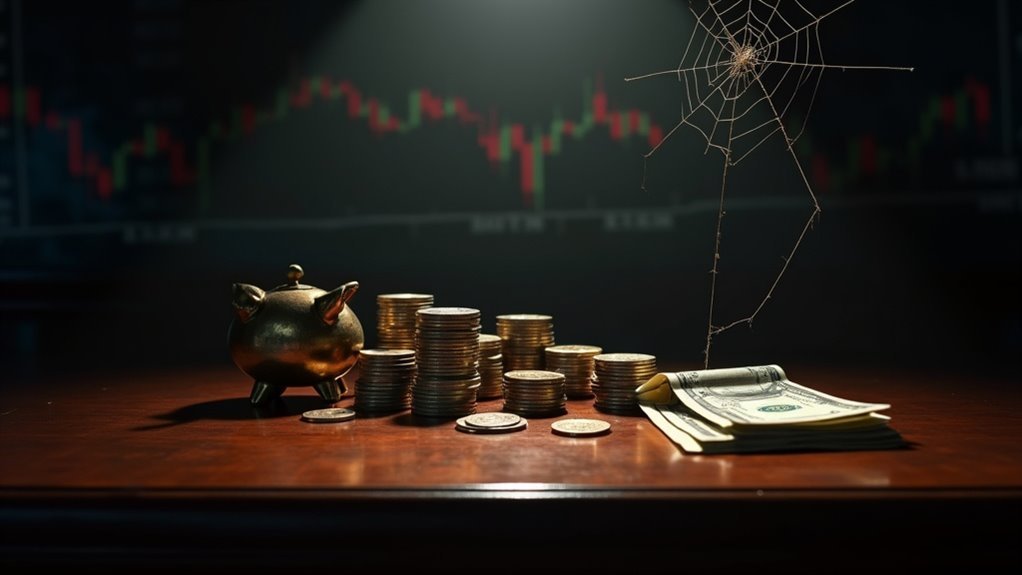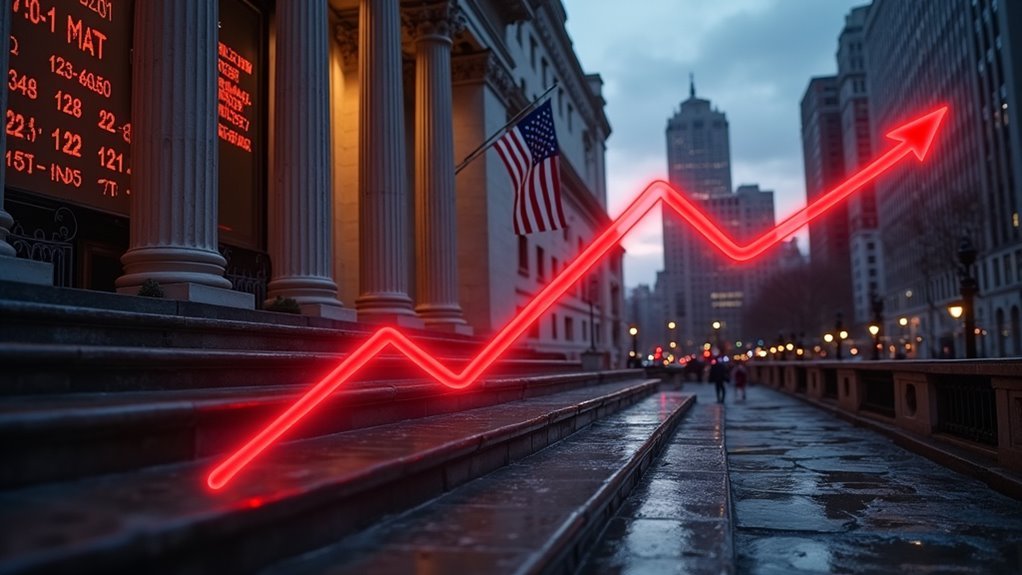Investment fees are wealth-draining vampires lurking in plain sight. Management fees range from 0.5% to 2% annually, while front-end loads can steal up to 5.75% immediately. Even “free” trading platforms hide costs in bid-ask spreads and market impact fees. Index funds charge around 0.44%, while active funds demand 0.74% – despite most failing to beat the market. The rabbit hole of hidden investment costs goes deeper than most realize.

Investors blindly hand over their hard-earned money to Wall Street, often unaware of the financial vampires lurking in the shadows. These costs silently drain investment accounts, year after year, with most people never noticing the steady drip of their wealth being siphoned away.
Management fees, those seemingly innocent percentages, can devour anywhere from 0.5% to 2% of assets annually. Not much? Think again. Low-cost index mutual funds provide a much better alternative with fees as low as 0.02% annually.
Those tiny management fees are financial vampires, steadily draining your wealth year after year while masquerading as harmless percentages.
The bloodletting doesn’t stop there. Sales loads and commissions pack a particularly nasty punch, with front-end loads stealing up to 5.75% of an investment before it even hits the market. That’s right – invest $10,000, and poof, over $500 vanishes instantly.
Back-end loads are just as sneaky, waiting to ambush investors when they sell their shares. At least some funds waive these fees for bigger investments, how generous of them.
Brokerage and trading fees add another layer of complexity. While many platforms now offer commission-free trading, full-service brokers still charge hefty fees – sometimes $50 or more per trade.
And those expense ratios? They’re the silent killers of long-term wealth accumulation. Index funds charge around 0.44% annually, while active funds demand a heftier 0.74% – death by a thousand paper cuts. A shocking 85% of active funds fail to beat the S&P 500, making their higher fees even harder to justify.
The financial advisory world has its own fee structure, typically claiming 1-2% of assets annually for their services. Sure, they might provide valuable planning and tax strategies, but that percentage compounds over time just like investment returns – except in reverse. Savvy investors can minimize these fees by utilizing tax-advantaged accounts for their retirement and long-term savings goals.
Then there are the truly hidden costs – the ones that don’t even show up on statements. Bid-ask spreads, market impact costs, and those mysterious soft dollar arrangements all benefit Wall Street insiders while picking investors’ pockets.
Don’t forget about taxes either – capital gains, mutual fund distributions, and wash sale rules create a maze of potential wealth-draining pitfalls. The house always wins, and in this case, the house is wearing an expensive suit on Wall Street.
Frequently Asked Questions
How Do Investment Fees Differ Between Retirement and Non-Retirement Accounts?
Retirement accounts like 401(k)s typically carry higher fees, averaging 2.2% all-in, compared to non-retirement accounts.
IRAs fall in the middle with 0.50% average expense ratios.
Regular brokerage accounts often have the lowest fees – zero-commission trades and minimal annual charges.
However, brokerage accounts face capital gains taxes up to 20%, while retirement accounts dodge that bullet.
The trade-off? Less investment freedom in retirement accounts.
Can I Negotiate Fees With My Financial Advisor or Brokerage Firm?
Yes, fees are often negotiable.
Financial advisors face stiff competition these days, especially from low-cost robo-advisors and discount brokers. Many will drop their rates by 0.25% or more, particularly for larger accounts or long-term clients.
Account size, relationship length, and service complexity all affect negotiating power. Some advisors even offer fee reductions in exchange for client referrals.
Market pressures have made flexibility the new normal.
Which Investment Vehicles Typically Have the Lowest Overall Fee Structure?
Direct Treasury securities and broad market index funds consistently rank as the fee champions. Treasuries purchased straight from Uncle Sam? Zero fees. Period.
Large index funds and ETFs from major providers come in at a microscopic 0.03-0.10% annually.
Direct stock ownership through commission-free brokers also keeps costs rock-bottom – just watch those trading impulses.
Robo-advisors aren’t too shabby either, but their 0.25-0.50% fee takes them out of the ultra-low-cost category.
How Often Should I Review and Rebalance My Portfolio to Minimize Costs?
Annual rebalancing works for most investors – no need to get fancy. More frequent tweaking just racks up costs.
Smart move? Wait until investments drift 5-10% from targets. Market chaos might demand more attention, but trading fees add up fast.
Some folks use new contributions to rebalance – saves on selling fees. Automation through robo-advisors can help, though they’re not free either.
Taxes matter – a lot.
Are Fee Structures Different for International Investments Compared to Domestic Ones?
International investments typically come with heftier price tags than domestic ones. No surprise there. The expense ratios run higher, currency conversion costs add up, and those pesky foreign taxes take their bite.
Throw in wider bid-ask spreads and pricier transaction costs – it’s like paying a premium for that fancy imported cheese.
Even passive international funds often cost 2-3 times more than their domestic counterparts.
Markets are gradually becoming more efficient though, slowly narrowing these fee gaps.








